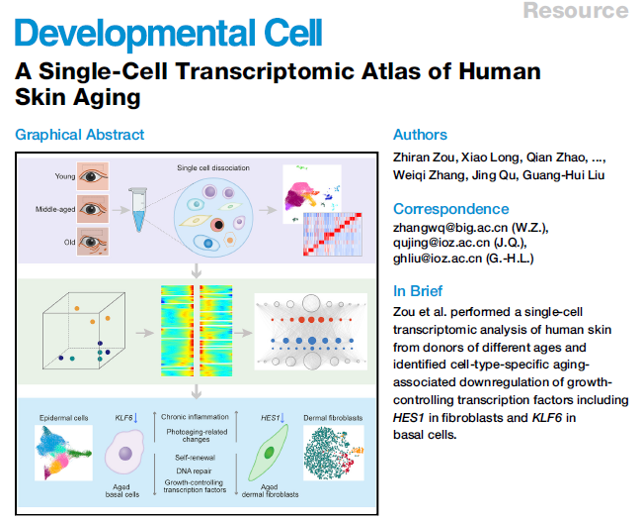文章信息:A Single-Cell Transcriptomic Atlas of Human Skin Aging
1.A Single-Cell Transcriptomic Atlas of Human Skin Aging
1.1 Highlights
- Single-cell transcriptional landscapes of human skin aging
- Dysregulation of cell-type-specific transcriptional networks during skin aging
- Quercetin promotes the rejuvenation of aged dermal fibroblasts
1.2 Summary
- skin: self-renewal; functional decline -> visible aging
- understanding aging: molecular and functional properties of skin cell types
- perform scRNA-seq of human eyelid skin across ages and identified 11 cell types, as well as 6 subpopulations of basal cells
- accumualtion of photoaging-related changes and increased chronic inflammation with age
- TFs involved in inhibition of HES1 and KLF6 (TF): compromised cell proliferation; increased inflammation and cellular senescence
- activation of HES1: allevitate cellular senescence of dermal fibroblasts
- Findings: provide a single-cell molecular framework of human sking aging
1.3 Methods
1.3.1 Processing Raw Data**
- Cell Ranger single-cell software suite (v2.2.0) (10x Genomics)
- aligned to the human reference genome (hg19) using a STAR aligner
- expression level for each transcript was determined using the number of unique molecular identifiers(UMI)
1.3.2 scRNA-seq Data Analysis and Cell-Type Identification**
- Seurat R package (version 2.3.4)
- cells with fewer than 500 genes or more than 5,000 genes detected, and more than 10% mitochondrial genes were further excluded
- obtain normalized UMI values by ‘‘NormalizeData’’ function
- ‘ScaleData’’ function was used to scale andcenter expression levels
- top 1,100 highly variable genes were used for canonical correlation analysis (CCA)
- Total cell clustering was performed by‘‘FindClusters’’ function at a resolution of 2.0 and the first 30 CCs were used to define cell identity
- Dimensionality reduction was per-formed with ‘‘RunUMAP’’ function and visualized by Uniform Manifold Approximation and Projection (UMAP)
- Marker genes for each cluster were determined with the Wilcoxon rank-sum test by ‘‘FindAllMarkers’’ function
-
Only those with ‘avg_logFC’ > 0.25and ‘p_val_adj’ < 0.05 were considered as marker genes
1.3.3 Identification of Aging-Associated DEGs**
- used‘‘FindMarkers’’ in Seurat to identify aging-associated DEGs between O/Y, M/Y, and old O/M for each cell type
1.3.4 Identification of Age-Dependent DEGs**
- ‘FindAllMarkers’’ in Seurat
- ‘plot_pseudotime_heatmap’’ function of the Monocle package
1.3.5 Gene Ontology (GO) Analysis**
- performed by Metascape and visualized with the ggplot2 R package
1.3.6 Pseudotime Analysis**
- Monocle2
1.3.7 Transcriptional Regulatory Network Analysis**
- GENIE3 (version 1.6.0) and RcisTarget (version1.4.1) R packages of the SCENIC (version 1.1.2.2)
1.3.8 Aging-Associated Coefficient of Variation Analysis**
- R package Seurat ‘‘FindVariableGenes’’ function
1.3.9 Gene Set Score Analysis**
- The‘‘AddModuleScore’’function of the Seurat R package
1.3.10 Cell-Cell Communication Analysis**
- CellPhoneDB software (version 1.1.0)
4.Take home message
4.1 这篇文章研究了什么(为什么研究这个)
- 想解决的问题:明确人皮肤衰老过程中的细胞和分子水平的改变。
- 研究的难点:人的表皮每4周进行一次补给;传统的混池RNA仅能评估细胞和组织中基因表达的平均水平,无法解释人类表皮细胞的异质性和可塑性。
- 解决的手段:利用单细胞转录组学测序技术绘制了不同年龄段的多种皮肤细胞类型的基因表达图谱。
- 结果:系统地绘制了人皮肤衰老的高通量单细胞转录图谱,发现了增龄伴随的生长控制转录因子的表达下调是人类皮肤衰老的驱动因素。
4.2 实验设计的思路和主要的分析流程
- 分别获取年轻、中年和老年人的眼睑皮肤样品。
- 通过组织染色分析,发现了包括表皮厚度、真皮胶原密度的降低等一系列增龄性变化。
- 采用单细胞转录组测序(scRNA-seq)技术对9例不同年龄的健康人眼睑皮肤进行了分析。
- 绘制了不同年龄段的多种皮肤细胞类型(包括表皮基底细胞、有棘细胞、颗粒细胞、黑色素细胞、真皮细胞等)的基因表达图谱。
- 鉴定了11种主要皮肤细胞类型,并将表皮基底细胞进一步划分为6个细胞亚群:3种静止型表皮干细胞(基底细胞)和3种放大型表皮干细胞(有丝分裂基底细胞)亚群。
- 通过在转录水平上鉴定不同组别中与年龄相关的差异表达基因(DEGs) ,发现衰老过程伴随着慢性炎症的增加和表皮自我更新能力的下降。
- 通过研究TF发现,在衰老过程中,真皮成纤维细胞和表皮角质形成细胞分别抑制发育调节的核心转录因子 HES1和 KLF6,导致皮肤增殖能力下降,衰老相关表型增加。
4.3 主要的研究结果
- 富含表皮干细胞的表皮基底细胞具有较高的异质性并可被分为6个细胞亚群。
- 中年组与老年组的皮肤相较于年轻组具有更为相似的转录组特征,提示眼部皮肤在中年时期已经发生显著的衰老相关基因表达变化。
- 相比于年轻个体,年老个体皮肤组织表现出炎症反应的增加和上皮维持能力的降低。由于眼睑皮肤处于日常阳光的照射下,多种衰老皮肤细胞的基因表达特征呈现DNA修复能力的降低以及生物大分子损伤的增加,表明光损伤和慢性炎症可能是眼部皮肤衰老的重要诱因。
- 表皮基底细胞中的KLF6和真皮成纤维细胞中的HES1这两种生长控制转录因子的下调是引发皮肤衰老的驱动力。在人原代表皮角化细胞和原代真皮成纤维细胞中分别敲低KLF6和HES1可加速细胞衰老,而在衰老的人原代真皮成纤维细胞中激活HES1则可延缓细胞衰老,提示了HES1可能具有干预皮肤衰老的活性。
- 发现天然化合物槲皮素能够延缓人真皮成纤维细胞衰老,为干预皮肤衰老提供了新策略。
4.4 研究的创新性和价值
- 该研究在国际上首次报道了人类眼部皮肤衰老的单细胞转录组图谱,系统地解析了人类皮肤中多种细胞类型的衰老规律,揭示了发育相关转录因子表达下调、细胞自我更新能力降低、慢性炎症是皮肤衰老的主要特征,并且发现了延缓皮肤衰老、防治衰老相关皮肤疾病的潜在途径。
- 这项研究为揭示人类皮肤干细胞的异质性和发展老化相关皮肤疾病的治疗策略提供了丰富的资源。
- 建立了衰老多组学数据库Aging Atla。
